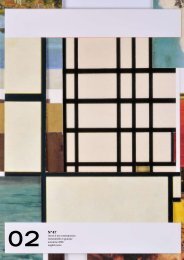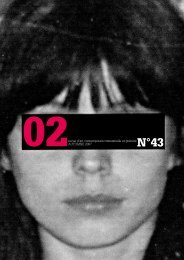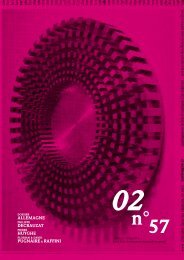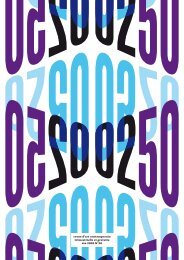N°46 / revue d'art contemporain trimestrielle et gratuite / été 2008 ...
N°46 / revue d'art contemporain trimestrielle et gratuite / été 2008 ...
N°46 / revue d'art contemporain trimestrielle et gratuite / été 2008 ...
You also want an ePaper? Increase the reach of your titles
YUMPU automatically turns print PDFs into web optimized ePapers that Google loves.
46<br />
Guests<br />
ces théories de l’esthétique relationnelle,<br />
aujourd’hui un peu mises à l’écart ?<br />
Il est évident que l’art est une entreprise<br />
essentiellement relationnelle,<br />
tout spécialement en raison de<br />
sa dimension fondamentalement<br />
communicative. Toute pensée <strong>et</strong><br />
toute action est relationnelle de par<br />
son intentionalité, <strong>et</strong> la vie même est<br />
relationnelle, parce que l’organisme<br />
doit constamment maintenir des<br />
relations satisfaisantes avec l’environnement<br />
duquel il tire son énergie.<br />
Pour en revenir à l’art, n’est-il pas<br />
maintenant évident – après tant de<br />
théories, depuis celles de T.S. Eliot,<br />
qui insistèrent sur le fait que le sens<br />
<strong>et</strong> la valeur d’une œuvre sont toujours<br />
fonction de ses relations avec<br />
d’autres œuvres – que l’artiste ou<br />
l’œuvre ne peuvent générer du sens<br />
d’une manière purement autonome,<br />
mais que les possibilités mêmes de<br />
création dépendent d’une matrice<br />
relationelle à la fois diachronique <strong>et</strong><br />
synchronique. Si j’ai critiqué la notion<br />
de monde de l’art élaborée par mon<br />
ami Arthur Danto, c’est parce qu’il<br />
tendait à le traiter comme un monde<br />
autonome d’art <strong>et</strong> de théorie, alors<br />
que de mon côté, je le vois plutôt<br />
profondément informé <strong>et</strong> conditionné<br />
par le monde plus vaste dans lequel<br />
il est intégré. Je pense que les<br />
œuvres ont réciproquement un<br />
impact sur ce monde social <strong>et</strong> qu’elles<br />
tendent à le remanier, bien que<br />
c<strong>et</strong>te influence ne soit pas toujours<br />
très claire ou même remarquable,<br />
étant donné l’importance des forces<br />
de séparation de l’art de la vie.<br />
Peut-être est-ce pourquoi vous,<br />
comme d’autres critiques européens,<br />
associez mes théories à ce que l’on<br />
appelle l’esthétique relationnelle. Je<br />
ne suis pas très familier des théoriciens<br />
que vous citez, car ils n’ont<br />
pas eu de véritable écho auprès des<br />
philosophes de l’art aux États-unis,<br />
mais je présume que leurs idées se<br />
rapportent à ce courant d’un art flexible<br />
<strong>et</strong> ouvert de la décennie passée,<br />
qui cherchait entre autres à brouiller<br />
les distinctions entre l’artiste <strong>et</strong> le<br />
public tout en soulignant la création<br />
d’une véritable communauté, bien<br />
que provisoire. Remarquant des liens<br />
entre une telle pratique de l’art <strong>et</strong> mes<br />
théories de l’expérience esthétique<br />
par-delà l’espace sacralisé des<br />
musées <strong>et</strong> des galeries, un critique<br />
d’art italien, Maurizio Bartolotti, organisa<br />
un événement d’expérimentation<br />
artistique à Venise en mai 2004,<br />
auquel il m’invita avec quelques artistes<br />
de c<strong>et</strong>te orientation relationnelle :<br />
Rirkrit Tiravanija, Philippe Parreno,<br />
Pierre Huygue <strong>et</strong> Maurizio Nannucci.<br />
Bien que j’aie une réelle sympathie<br />
pour les visées artistiques <strong>et</strong> sociales<br />
ressortissant à c<strong>et</strong>te approche, je ne<br />
les considère pas comme supérieures<br />
à d’autres façons de faire de l’art.<br />
Ma position théorique est pluraliste.<br />
L’art peut exprimer son indéniable<br />
condition relationnelle ainsi que sa<br />
condition essentiellement sociale<br />
de bien des manières. J’ai récemment<br />
eu une conversation instructive avec<br />
Tatiana Trouvé (8) à propos de son<br />
intriguant travail qui, bien qu’apparemment<br />
très éloigné de celui des<br />
artistes relationnels sus-mentionnés,<br />
réussit à faire ressortir notre sens<br />
des relations sociales <strong>et</strong> spatiales qui<br />
gouverne notre expérience de la vie<br />
<strong>et</strong> de l’art.<br />
Vous concluez votre essai Sous l’interprétation<br />
par l’idée d’une inclusion de<br />
pratiques non-discursives, comme les<br />
disciplines somatiques, dans la philosophie,<br />
afin de, je vous cite « donner à<br />
la qualité de l’expérience immédiate le<br />
statut d’une fin pratique <strong>et</strong> d’un outil<br />
opportune » (9). Quelles conséquences<br />
à cela peut-on envisager dans le<br />
domaine de l’esthétique ?<br />
Il y a à c<strong>et</strong>te question une réponse<br />
longue <strong>et</strong> complexe à laquelle je<br />
compte travailler un bon moment<br />
dans le cadre de mon proj<strong>et</strong> de<br />
recherche sur la soma-esthétique.<br />
une partie de la réponse se<br />
trouve dans mon dernier ouvrage,<br />
Conscience du corps. Il est toujours<br />
ennuyeux de simplifier des arguments<br />
élaborés dans de p<strong>et</strong>ites phrases<br />
formatées pour les interviews. Mais<br />
pensez au fait élémentaire que le<br />
soma – le corps vivant <strong>et</strong> sentant<br />
– est le médium fondamental <strong>et</strong><br />
indispensable de notre perception<br />
<strong>et</strong> l’instrument essentiel de toute<br />
notre action, ce qui inclut la création<br />
artistique <strong>et</strong> son appréciation. Si les<br />
disciplines soma-esthétiques peuvent<br />
affiner notre acuité perceptive <strong>et</strong><br />
notre appréciation sensorielle en<br />
général, alors elles peuvent certainement<br />
améliorer notre aptitude à percevoir<br />
<strong>et</strong> nos capacités d’expérience<br />
dans des contextes esthétiques –<br />
créatifs autant que critiques. Pensez<br />
à ce qu’une meilleure conscience<br />
sensori-motrice peut perm<strong>et</strong>tre à<br />
des performeurs (musiciens, acteurs,<br />
danseurs, <strong>et</strong> autres) d’améliorer leurs<br />
postures <strong>et</strong> mouvements de manière<br />
à exécuter leur œuvre avec plus<br />
d’aisance <strong>et</strong> moins de douleur <strong>et</strong> de<br />
fatigue. Pensez à la façon dont les<br />
artistes qui réalisent des installations<br />
peuvent fructueusement jouer avec<br />
de subtils ressentis de l’espace qui<br />
peuvent être saisis proprioceptivement<br />
ou kinesthésiquement, <strong>et</strong><br />
non simplement visuellement ou<br />
conceptuellement. Pensez à ce<br />
que l’esthétique traditionnelle traite<br />
si peu de ce type de perceptions.<br />
Ainsi, la soma-esthétique ne peut<br />
que suggérer de nouvelles directions<br />
d’exploration esthétique, en théorie<br />
comme en pratique.<br />
(1) John Dewey, Art as Experience, (1934), Perigee<br />
Books, New York, 1980, p. 46 : « Nous n’avons pas<br />
de mot, en anglais, qui inclurait sans ambiguïté<br />
les significations des deux mots “artistique” <strong>et</strong><br />
“esthétique”. Comme “artistique” fait référence<br />
avant tout à l’acte de production <strong>et</strong> “ esthétique”<br />
à celui de perception <strong>et</strong> de plaisir, l’absence de<br />
terme désignant les deux processus ensemble est<br />
regr<strong>et</strong>table. »<br />
(2) Richard Shusterman, L’Art à l’état vif : la pensée<br />
pragmatiste <strong>et</strong> l’esthétique populaire, Paris, éd.<br />
de Minuit, 1992 <strong>et</strong> Vivre la philosophie, Paris, éd.<br />
Klincksieck, 2001.<br />
(3) Nicolas Bourriaud, Esthétique relationnelle, Les<br />
Presses du réel, 2001, p. 84.<br />
(paru en anglais en 2002 sous le titre de Relational<br />
Aesth<strong>et</strong>ics)<br />
(4) ibid, p. 85.<br />
(5) Liam Gillick, Proxemics, Selected Writings (1988-<br />
2006), JRP Ringier & Les Presses du réel, 2006, p.<br />
268.<br />
(6) ibid, p. 265.<br />
(7) Richard Shusterman, Sous l’interprétation, traduit<br />
de l’anglais par J- P.Com<strong>et</strong>ti, éd. de L’Éclat, 1994,<br />
p. 82.<br />
(8) Interview à paraître dans le catalogue monographique<br />
de Tatiana Trouvé, Verlag der Buchhandlung<br />
Walther König, Köln <strong>2008</strong> (textes de Tatiana<br />
Trouvé, Catherine Mill<strong>et</strong>, Robert Storr, interview de<br />
l’artiste par Richard Shusterman).<br />
(9) Richard Shusterman, Sous l’interprétation, p. 93.<br />
Richard Shusterman, Conscience du corps, Pour<br />
une soma-esthétique, traduit de l’anglais par<br />
Nicolas Vieillescaze, éd. de L’Éclat, Paris-Tel Aviv,<br />
2007.<br />
Richard Shusterman, Body Consciousness. A<br />
Philosophy of Mindfulness and Somaesth<strong>et</strong>ics,<br />
Cambridge university Press, Cambridge, <strong>2008</strong>.<br />
Richard Shusterman, Docteur en philosophie,<br />
enseigne au Dorothy F. Schmidt College of Arts<br />
and L<strong>et</strong>ters, Florida Atlantic university. Il y dirige<br />
aussi le Center for Body, Mind and Culture.<br />
www.shusterman.n<strong>et</strong><br />
www.fau.edu/bodymindculture<br />
for richard shusterman, philosophy<br />
acquires a practical utility the<br />
moment it disengages from its<br />
endless search for fundamentals<br />
and takes up residence in the<br />
interstices of the real, construing<br />
itself as a critical experience of the<br />
world. faced with a contemporary<br />
culture which makes the body suffer<br />
through the r<strong>et</strong>urn of bikini weather<br />
(di<strong>et</strong>s, jogging…) or digitalizes it<br />
almost to the point of effacement<br />
(facebook…) and a philosophical<br />
pragmatism which, by way of<br />
the linguistic turn, has managed<br />
to assimilate the “i” into its own<br />
language, richard shusterman<br />
proposes a concr<strong>et</strong>e way of thinking<br />
about our prison of skin —at once<br />
theor<strong>et</strong>ical orientation and practical<br />
tool, as close to the hellenistic<br />
philosophers as it is to the thinkers<br />
of the 20 th century. and since there<br />
would be no aesth<strong>et</strong>ics without<br />
soma —without, that is, a body at<br />
once living and feeling— the release<br />
of his most recent book in english<br />
provided the occasion for a r<strong>et</strong>urn<br />
to the bases aesth<strong>et</strong>ics.<br />
Aude Launay. Reading your written<br />
works and, especially, the last one,<br />
Body Consciousness, we easily g<strong>et</strong> an<br />
idea of the predominance of aesth<strong>et</strong>ics<br />
in your work, hence the discipline you<br />
created: somaesth<strong>et</strong>ics. According to<br />
you, aesth<strong>et</strong>ics, in its broadest sense,<br />
as it deals with that which might be the<br />
most universal for us, that is to say, our<br />
ability to perceive the world with our<br />
senses, could really influence politics.<br />
Somaesth<strong>et</strong>ics is thus both an attention<br />
to our feelings and the development of<br />
sociocultural behaviour; it is an activity,<br />
a use of the world that generally operates<br />
through pleasure (wh<strong>et</strong>er it be<br />
sports, dining, meditation, <strong>et</strong>c.) So it<br />
goes beyond the distinction John Dewey<br />
drew b<strong>et</strong>ween the aesth<strong>et</strong>ic and the<br />
artistic (1) , combining both meanings in a<br />
single process. You recommend some<br />
kind of a “moderate action” to counter<br />
the inherent passivity of aesth<strong>et</strong>ics.<br />
Is aesth<strong>et</strong>ics, strictly speaking, now<br />
obsol<strong>et</strong>e?<br />
Richard Shusterman. Before responding<br />
to your specific question, I should<br />
clarify that somaesth<strong>et</strong>ics is not really<br />
my own discipline in the sense of<br />
sole ownership. Though I initiated<br />
the concept of this field or discipline<br />
of theory and practice, there are<br />
now many others (philosophers and<br />
theorists in the arts, in design, in education<br />
and other fields) who deploy<br />
the term and work in its framework.<br />
Somaesth<strong>et</strong>ics is not limited to the<br />
study and pursuit of gentle movements<br />
or actions; there is also value<br />
and need for hard or violent actions<br />
to be explored in both theory and life<br />
—and of course in art, whose violent<br />
dimensions I have defended in some<br />
of my writings, especially in my texts<br />
on rap in Pragmatist Aesth<strong>et</strong>ics<br />
(Blackwell, 1992) and Practicing<br />
Philosophy (Routledge, 1997). Styles<br />
of action need to be evaluated always<br />
in terms of a context. You are right,<br />
however, that my new book, Body<br />
Consciousness: A Philosophy of<br />
Mindfulness and Somaesth<strong>et</strong>ics<br />
emphasizes the importance of attuning<br />
or training one’s soma (by which<br />
I mean one’s living, sentient, perceptive<br />
and active body-mind) to appreciate<br />
the values and pleasures of<br />
very subtle qualities, sensations,<br />
and action. This is in contrast to our<br />
culture’s emphasis on escalating the<br />
intensities of sensory stimuli to often<br />
violent proportions which result (as<br />
we know from basic principles of<br />
psychology and neurophysiology) in<br />
a general dulling of our sensibilities<br />
and capacities for pleasure. It is much<br />
easier to distinguish such subtl<strong>et</strong>ies<br />
of perceptions and pleasures, when<br />
one is engaged in gentle and slowmoving<br />
action —or indeed when one<br />
is in a relative state of rest. That is<br />
one reason why I have found zazen<br />
meditation or the very slow movements<br />
of Feldenkrais M<strong>et</strong>hod and tai<br />
chi chuan very useful in developing<br />
my own capacities of perception and<br />
pleasure. This may seem remote from<br />
aesth<strong>et</strong>ics as conventionally understood<br />
in philosophy departments or<br />
in the traditional artworld, but as you<br />
know, I regard aesth<strong>et</strong>ics as including<br />
the broad aim of exploring and<br />
enlarging our capacities of perception.<br />
And it is impossible for there to<br />
be perception without action. We turn<br />
our head and open our eyes to see;<br />
perception always involves our active<br />
muscles, not an immaterial unmoving<br />
mind. If this view of aesth<strong>et</strong>ics seems<br />
radical, it only goes back to the roots<br />
of this concept which derives from<br />
the Greek term for sensory perception.<br />
This does not mean that aesth<strong>et</strong>ics<br />
in the more narrow, conventional,<br />
sense of beauty in nature and art will<br />
become obsol<strong>et</strong>e. But I do hope that<br />
my arguments will undermine the idea<br />
that aesth<strong>et</strong>ic perception is inherently<br />
passive, an idea that John Dewey also<br />
strongly challenged.<br />
“Strictly speaking” meant for me this<br />
Greek sense of sense perception…<br />
This idea of an active perception has<br />
long been developed since the sixties,<br />
especially in theatre and contemporary<br />
art. We might then think that such a<br />
concept, which has underlain what<br />
we call relational aesth<strong>et</strong>ics, would<br />
definitely change the way artists make<br />
art, and the way the audience receive it.<br />
Unfortunately, nowadays there are fewer<br />
artists whose work could pertain to such<br />
a way of thinking than at the time when<br />
Nicolas Bourriaud theorized this. Reading<br />
Pragmatist Aesth<strong>et</strong>ics: Living Beauty,<br />
R<strong>et</strong>hinking Art, as well as your recent<br />
writings and interviews, it seems that<br />
relational aesth<strong>et</strong>ics, in its basic points<br />
is an obvious fact: “If one does not g<strong>et</strong><br />
anything out of a work, it is because he<br />
or she is not working hard enough” (2) ,<br />
“No one writes, paints or creates alone,<br />
but we have to pr<strong>et</strong>end that we do” (3) ,<br />
Biological Aesth<strong>et</strong>ics<br />
richard Shusterman<br />
an interview by Aude Launay<br />
“(…) str<strong>et</strong>ch(ed) and compress(ed) time<br />
to provide a new matrix of interactions—<br />
among people who are normally forced<br />
to remain focused on a simple relationship<br />
b<strong>et</strong>ween ‘viewer’ and ‘producer’ (4) ”,<br />
“It is hard to know when the ‘moment of<br />
art’ starts or ends” (5) . In this way, it could<br />
be like an extention, in the field of art, of<br />
John Dewey’s continuist conception…<br />
You even say that “the mind had never<br />
been an external observer of the natural<br />
world, but a part of it that separated<br />
from it.” (6) How do you feel about these<br />
theories of relational aesth<strong>et</strong>ics that have<br />
now been sort of pushed to the side?<br />
Yes, I do think it’s obvious that art is<br />
an essentially relational enterprise,<br />
especially due to its fundamentally<br />
communicative dimension. But,<br />
of course, all thought and action<br />
are relational through their basic<br />
intentionality, and indeed all life is<br />
relational, since it is always a matter<br />
of the organism’s ability to maintain<br />
satisfactory relationships with the<br />
environment from which it draws its<br />
energies. Coming back to art, isn’t<br />
it obvious by now —after so many<br />
theories (even as far back as T.S.<br />
Eliot’s) emphasizing that an artwork’s<br />
meaning and value are always a function<br />
of its relations with other works in<br />
47<br />
Guests







